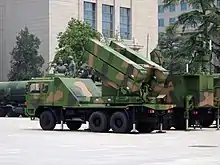LY-60 / FD-60 / PL10
The LY-60/FD-60/PL-10/HQ-6/6D/64 is a family of Chinese missiles developed by the Shanghai Academy of Science and Technology, largely based on the Italian Selenia Aspide missile - itself based on the American AIM-7 Sparrow missile. There are four versions of the basic design, three of which are surface-to-air and one air-to-air.
| LY-60/PL-10 | |
|---|---|
 HQ-6A Surface-to-air missiles mounted with road-mobile launcher | |
| Type | air-to-air & surface-to-air missiles |
| Place of origin | China |
| Service history | |
| In service | late 1980s – present |
| Used by | China, Pakistan |
| Production history | |
| Manufacturer | Shanghai Academy of Science and Technology |
| Produced | since late 1980s |
| Specifications | |
| Mass | 220 kg |
| Length | 3.69 meter |
| Diameter | 203 mm |
| Warhead | 33 kg warhead |
Detonation mechanism | impact / proximity |
| Engine | rocket motor |
| Propellant | solid fuel |
Operational range | 18 km for SAM, 60 km for AAM |
Guidance system | SARH / ARH |
Launch platform | Air & surface |
Development
Development of the LY-60 was precipitated by the Chinese requirement for a beyond-visual-range (BVR) weapons system. Directly copying the AIM-7 proved unsuccessful, after which China purchased a number of Alenia Aspide missiles from Italy. Due to the urgent need for BVR air-to-air missiles, PL-11 was given the priority. The very first batch of PL-11 was an Aspide assembled in China, but using Italian components, and it was accepted into Chinese service in the same year. However, hopes of locally manufacturing the missile under license collapsed after the Tiananmen Square crackdown of 1989.
HQ-6
The HQ-6 ("Red flag-6") was the second member of the LY-60/PL-10/HQ-6/6D/64/DK-10 family developed, but it entered service before the air-to-air version PL-10, despite an earlier start by the PL-10. The entire SAM system consists of four truck mounted radars (one search/surveillance radar and three tracking/fire control radars), one power supply truck, and six transporter erector launchers (TEL)s. The missile itself is directly derived from the air-to-air version PL-11. Unlike the Italian Aspide which uses containers as launchers, HQ-6 uses missile launching rails (MLR) instead, and each truck-mounted launcher has two MLRs/missiles. Specifications:[1]
- Length: 5.99 m
- Diameter: 134 mm
- Wingspan: 1.23 m
- Weight: 600 kg
- Speed: Mach 1
- Maximum Flight Speed: 150 meters per second
- Maximum maneuvering overload: 5 g
- Maximum maneuvering overload [interception]: 1 g
- Range
- Normal: 5 meters - 40 meters
- Slant: 14 meters - 16 meters
The PL-10 (Pi Li, "Thunderbolt") air-to-air missile was developed for the People's Liberation Army Air Force (PLAAF), and is carried by Jian J-8B fighters. Although it was the first member of the LY-60/PL-10/HQ-6/6D/64/DK-10 series to be developed, it was actually the second member to become operational, after the HQ-6, the surface-to-air version.
K/AKK-10
During the mid-life upgrade of PL-10, the semi-active radar homing (SARH) seeker was replaced by active radar homing (ARH) seekers, resulting in two versions, one with a Russian ARH seeker, the other with a domestic Chinese ARH seeker. The K/AAK-10 is the version with an active seeker, but it's not clear if it is the one with a foreign ARH seeker or a domestic seeker.
In October 1994 the new medium-low-altitude surface-to-air missile system, the "Lieying (Falcon)-60," was deployed to China's air defense troops. The system is mainly intended for the interception of military aircraft and missiles flying in medium-low altitude. It a command control system with artificial interference capability thanks to the use of microprocessor intelligent module technology. This technology is not found on existing medium-low-altitude air defense missiles of other countries. The "Lieying-60" search radar can simultaneously track up to 40 targets, and the tracking radar is able to simultaneously track 12 targets, and engage three targets at once. The use of the moving target tracking processing system and frequency agility technology also gives the system good anti-jamming capability.
The LY60N SAM is being deployed in place of the HQ61 SAM used in the Jiangwei-class frigates. Compared with the HQ61 with a range of 12 kilometers and maximum altitude of 10 kilometers, the LY60 has a range of 18 kilometers and reaches a maximum altitude of 12 kilometers. The LY60N is installed in Jiangwei B-class frigates that have recently been placed in service. Every launch system features a sextuple launchers and each launcher contains four LY60N missiles, for a total of 24 missiles. The wings of the LY60N are foldable. In comparison, the LY60 of the ground army version features a quadruple launchers, each of its launcher contains one missile, and its missile wing is not foldable.
The system will be adopted as the shipborne vertically-launched air defense system of the Chinese Navy's "Luhai"-class missile destroyers, with at least eight vertical launch barrels with a total of 32 missiles.
China initially tried to address its beyond visual range [BVR] needs by reverse-engineering the semiactive AIM-7 Sparrow, in a program designated PL-10. This effort proved unsuccessful. China then purchased around 100 Aspide missiles from Italy--the eventual intent being the license-manufacture of the missile, to be known as PL-11. This deal collapsed as a result of the 1989 Tiananmen Square massacre.
The Air Force version of the LY-60 is the FD-60 semi-active radar-guided air-to-air missile carried by the J8B fighter plane, which is very similar to the Aspide AAM of Italy in appearance. This missile, which is evidently also known as the PL-10 [Pili = Thunderbolt, or Pen Lung = Air Dragon] medium range air-to-air missile is a Chinese copy of the Italian Aspide, which was developed from the American AIM-7E Sparrow. The bodies of the two missiles are generally similar, though the wings of the air-to-air PL-10 mirror those of the Sparrow, while the LY-60 wings have evidently been truncated to improve storage. The application of the same missile to both air-to-air and ship-to-air applications emulates the American practice with the Sparrow, which started life as an air-to-air missile with subsequent shipboard deployments.
In addition, the Shanghai Academy has also developed a portable ground-to-air version called the FY-60.
HQ-64
The HQ-64 is an improved version of the HQ-6, utilizing experience gained from LY-60, with firepower doubled by increasing the number of missiles for each truck mounted launcher from two to four, and by replacing the MLR mounting by missiles in container box launchers. Both the missile and TELs are directly developed from the LY-60. Although the missile is smaller than that of the HQ-6, the performance actually improved due to technological advances. HQ-64 passed state certification test and was accepted into Chinese service in 2001.[2] The reaction time for the system in fully automated mode is 9 seconds and the maximum speed of the missile is increased to Mach 4. Other improvements is mainly concentrated on ECCM capability, and many Chinese internet sources have claimed (yet to be confirmed) that the HQ-64 is derived from HQ-6-4, meaning 4 missiles (for each launcher) version the HQ-6.
HQ-6D
The HQ-6D is the latest development of the family, and it is basically a HQ-64 system with an addition of a command vehicle. Each command vehicle is able to command & control up to four HQ-64 batteries,[3] thus linking up independent HQ-64 batteries to form an integrated air defense net work, and each HQ-6D network can in turn be integrated into larger air defense network. The standard time that the HQ-6D SAM system takes from travelling order to being ready to fire is less than 15 minutes, but a highly skilled crew can reduce this time to just 9 minutes.[4][5]
Deployment and Export
It was once thought that the naval variant, the LY-60N, would replace the Hongqi-61 as the point defense missile of Chinese warships. However, it would seem the weapon is passed over in favor of the HQ-7, which now equips the Luhai class destroyer, Luhu class destroyer, and Jiangwei class frigate, because only a very limited number of land-based systems entered Chinese service for port/harbor defense.
The LY-60N was, however, exported to Pakistan in the 1990s to re-fit its purchase of 6 ex-Royal Navy Type 21 frigates, re-classified as the Tariq class. Three Tariq class ships were fitted with the 6-cell LY-60N SAM, the other three with 2×2-cell Harpoon anti-ship missiles.[6][7]
Additionally, a man-portable SAM version was developed designated FY-60.
References
- "迟到的利器——试析军演中的红旗6D防空导弹". www.zgjunshi.com. Archived from the original on 2012-03-30. Retrieved 2011-08-14.
- "红旗6(红旗61/红旗63/红旗64)中低空防空导弹". www.zgjunshi.com. Archived from the original on 2012-03-30. Retrieved 2011-08-14.
- "成空地空导弹旅列装国产红旗-6D新型导弹9分钟完成战斗准备_007兄弟_新浪博客". blog.sina.com.cn. Archived from the original on 2012-10-20. Retrieved 2011-08-14.
- "成空列装新型红旗-6D防空导弹 9分钟完成战斗准备_军事频道_凤凰网". news.ifeng.com. Archived from the original on 2011-08-31. Retrieved 2011-08-14.
- "HQ-6D exercise" Archived 2011-07-13 at the Wayback Machine
- http://www.defensenews.com/story.php?i=4275032%5B%5D
- "Pakistan Navy's Tariq Class (UK-Amazon Type-21) Frigates". Archived from the original on 2005-12-10.
- 19960619, National Air Intelligence Center (NAIC): "Lieh Ying: The Chinese-built Surface to Air Missile Weapon System", An Hua, NAIC-ID(RS)T-0253-96
